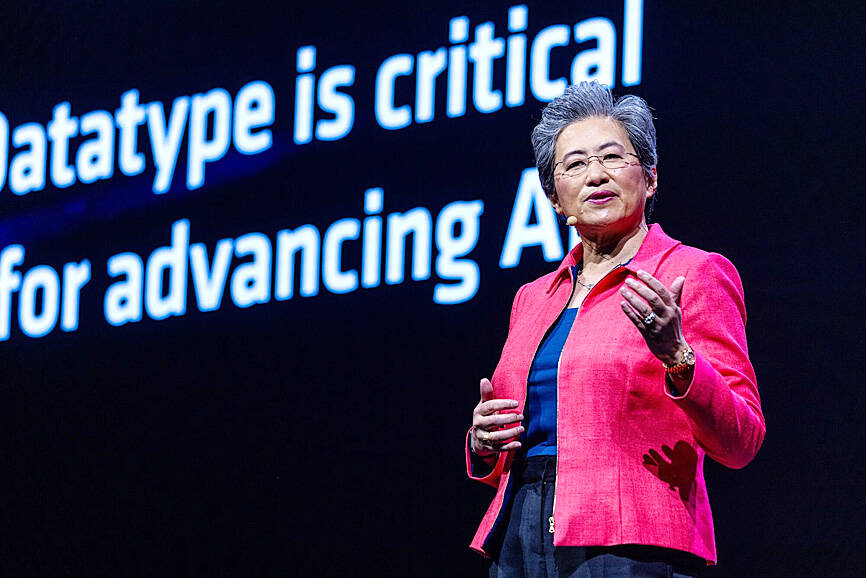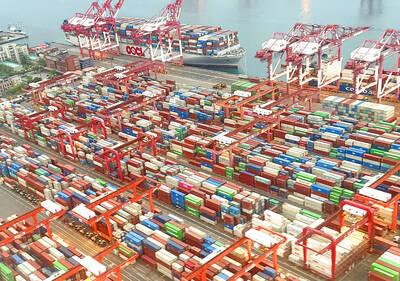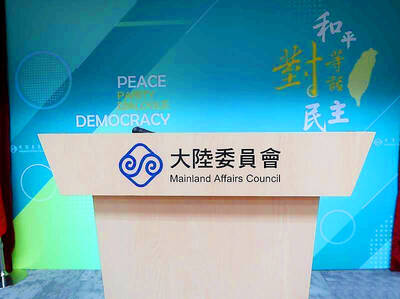Advanced Micro Devices Inc (AMD) is to set up a research and development (R&D) center in Taiwan with research teams targeting several advanced technologies, including silicon photonics, artificial intelligence (AI) and heterogeneous integration, a Ministry of Economic Affairs official said on Saturday.
An AMD application for the ministry’s A+ global R&D and innovation partnership program was approved this month, granting a more than 30 percent subsidy, or NT$3.31 billion (US$100.82 million), of the company’s total NT$8.64 billion investment, the ministry’s Web site showed.
AMD, a US-based central processing unit (CPU) producer and AI chip giant, would invest NT$5.33 billion, while 50 percent of its R&D workforce would be foreign talent, the ministry said.

Photo: Annabelle Chih, Bloomberg
Department of Industrial Technology Director-General Chiou Chyou-huey (邱求慧) wrote about the details of negotiations with the tech giant over the past year on social media.
The department team visited AMD headquarters in Santa Clara, California, while attending an APEC meeting in Seattle last year, Chiou said.
“Just a month before our visit, AMD had a market value of US$170 billion, surpassing Intel Corp and becoming the world’s most valuable CPU company and second in terms of AI chips,” he wrote.
After nearly a year of discussions and reviews, the investment plan was confirmed following a meeting on June 5 during Computex Taipei between AMD CEO Lisa Su (蘇姿丰) and Minister of Economic Affairs J.W. Kuo (郭智輝), Chiou said.
AMD has promised to set up research teams focusing on silicon photonics, AI and heterogeneous integration in Taiwan, he said.
Silicon photonics and heterogenous integration are promising technologies for advancing IC efficiency, as traditional silicon chip technology has reached its physical limits.
Because the software AMD uses for its graphics processing units is open source, meaning it is freely available and can be modified, “we also negotiated for more local companies to have cooperation opportunities with AMD,” Chiou said.
As a result, 33 domestic companies would be included in the research program, “pushing the value of the investment up to NT$15 billion and cultivating more than 1,000 AI specialists in Taiwan every year” during the three-year program, he said.
Separately, the ministry last month approved four Taiwanese teams to receive free access to “Taipei-1,” a supercomputer built by US-based Nvidia Corp, to boost their R&D capabilities.
Taipei-1 was launched in Kaohsiung late last year and partly funded by the government to develop AI technologies and products.
The computer would help the teams — the first batch of applicants for the government campaign — with R&D on a wide range of topics from large language model training and chip design to smart healthcare and autonomous driving, the ministry said on June 25.
The teams, selected from nearly 30 companies, universities and research institutions in Taiwan, would each be able to use 25 percent of Taipei-1’s computing power for six weeks from July 1 to Sept. 30, it said.
This is the first time the government has secured AI computing power from a foreign company for Taiwan, Chiou said.
Such access is expected to last for two and a half years and is valued at approximately NT$400 million, he said.

CARROT AND STICK: While unrelenting in its military threats, China attracted nearly 40,000 Taiwanese to over 400 business events last year Nearly 40,000 Taiwanese last year joined industry events in China, such as conferences and trade fairs, supported by the Chinese government, a study showed yesterday, as Beijing ramps up a charm offensive toward Taipei alongside military pressure. China has long taken a carrot-and-stick approach to Taiwan, threatening it with the prospect of military action while reaching out to those it believes are amenable to Beijing’s point of view. Taiwanese security officials are wary of what they see as Beijing’s influence campaigns to sway public opinion after Taipei and Beijing gradually resumed travel links halted by the COVID-19 pandemic, but the scale of

TRADE: A mandatory declaration of origin for manufactured goods bound for the US is to take effect on May 7 to block China from exploiting Taiwan’s trade channels All products manufactured in Taiwan and exported to the US must include a signed declaration of origin starting on May 7, the Bureau of Foreign Trade announced yesterday. US President Donald Trump on April 2 imposed a 32 percent tariff on imports from Taiwan, but one week later announced a 90-day pause on its implementation. However, a universal 10 percent tariff was immediately applied to most imports from around the world. On April 12, the Trump administration further exempted computers, smartphones and semiconductors from the new tariffs. In response, President William Lai’s (賴清德) administration has introduced a series of countermeasures to support affected

Pope Francis is be laid to rest on Saturday after lying in state for three days in St Peter’s Basilica, where the faithful are expected to flock to pay their respects to history’s first Latin American pontiff. The cardinals met yesterday in the Vatican’s synod hall to chart the next steps before a conclave begins to choose Francis’ successor, as condolences poured in from around the world. According to current norms, the conclave must begin between May 5 and 10. The cardinals set the funeral for Saturday at 10am in St Peter’s Square, to be celebrated by the dean of the College

CROSS-STRAIT: The vast majority of Taiwanese support maintaining the ‘status quo,’ while concern is rising about Beijing’s influence operations More than eight out of 10 Taiwanese reject Beijing’s “one country, two systems” framework for cross-strait relations, according to a survey released by the Mainland Affairs Council (MAC) on Thursday. The MAC’s latest quarterly survey found that 84.4 percent of respondents opposed Beijing’s “one country, two systems” formula for handling cross-strait relations — a figure consistent with past polling. Over the past three years, opposition to the framework has remained high, ranging from a low of 83.6 percent in April 2023 to a peak of 89.6 percent in April last year. In the most recent poll, 82.5 percent also rejected China’s